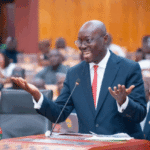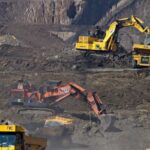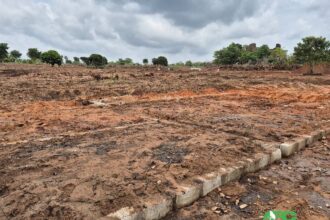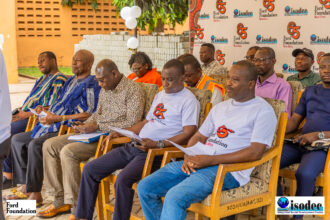There is no gainsaying the fact that, the practice of illegal and ecologically destructive mining is not sustainable nor is it in the national interest and must therefore be discredited, abandoned and permanently.
The launching by government of the war against illegal mining early this year came with a six-month long ban on illegal mining and suspension of mining activity in the small scale mining industry as a whole. This was therefore greeted with much enthusiasm from a cross section, of the civil society, with a lot of media support.
A reappraisal of the situation on the ground over the six-month period raises so many critical questions .That is, granted that some illegal miners were on record to have defied the ban and plied their trade in the night.
The bold, daring and recalcitrant ones did it during day time amidst threats to government that they would not vote for it in 2020.Some threatened that they would resort to armed struggle like what goes on in some other African countries.
It is worthy to pose for a brief moment and soberly reflect on the matter. Would it not have been possible for Government to have a well calculated anti-galamsey programme with a strategic action plan with details, clear cut and set out objectives, methodology of achieving them with time lines, within the context of a Master Plan?
We can recall that the PPP had to threaten the government with an ultimatum that, if government didn’t end galamsey within three months, it would drag it to the International Criminal Court (ICC). Lobby groups like the PPP could have proposed a Master Plan and Blue print to the government rather pressurizing it into adopting what looks like a knee jerk approach?
For instance, it would have been a lot more useful if the government, ahead of a ban, had first considered education and awareness creation campaigns targeting the most vulnerable in the mining communities – jobless women, children, youth who provide cheap labour for illegal mine owners in order just to earn a living. This could have been complemented by an outreach programme supported by environmental NGOs to educate the most vulnerable ones to appreciate how dangerous and unsustainable what they are doing is?
As it stands now, we only heard of alternative livelihood programmes through Lands and Natural Resources Ministry sources amidst the ban on TV show discussions. These alternative sources of livelihood could have been introduced concurrently with the ban and for that matter in exchange for the ban on illegal source of livelihood?
For if they are asked to stop abruptly their only source of daily bread which though admittedly, is untenable and very injurious to the environment, but without offering them readily available alternatives, this becomes problematic as it has turned out to be.
It is obvious that the war against galamsey need to be looked at once again more dispassionately and with much caution and circumspection especially as “Operation Vanguard ”swings into action in full force with some excesses already being committed as reported. Looking at the military arsenals marshaled against illegal miners as if they were enemy forces, we wish to caution that the galamsey operators no matter how injurious their activities are to the nation are still our very kith and kin no matter what.
Root Causes and Caudal Factors
There is a local proverb in Dagbani that “if one falls one shouldn’t be so concerned about the point of fall but about the point where one tripped “ to wit, it is more prudent to identify the root cause of a problem and try to address it holistically rather only making much effort in trying to solve it.
Against this back ground, it is prudent to ask that, when did the galamsey matter start and under what circumstances has it gotten this far? This then brings us to the point of looking at the historical antecedents of illegal mining.
The IMF/World Bank, under their sponsored Economic Recovery Programmes(ERP 1 and 11 did also provide an enabling ground for large scale mining to thrive between 1983-1999.This went at a heavy ecological cost to Ghana but much to the gross corporate profit gains of foreign mining multinationals. Indeed mining was encouraged at the expense of agriculture.
The commercial mining agenda received a lot of European Investment Bank (EIB) funding. This was carried forward into the era of 2001-2013 and sometimes referred to in global mining industry circles, as “Ghana’s mining boom”.
Foreign investment in Ghana’s mining sector alone accounted during days and even still as of today, accounts for a greater chunck of Foreign Direct Investment (FDI)
Globally, FDI inflows to the agricultural sector is about 5 per cent whilst in Ghana FDI inflows into the extractive sector accounts for about 70 per cent of the total FDI inflows into the economy of Ghana.
It is on records that, as at 1998, government had granted more than two hundred mining leases resulting in mining companies holding 30 per cent of the country’s lands surface area in mining concessions
Some multinational mining companies like AngloGold Ashanti, Newmont among others, are on record to have polluted water bodies leading to the depletion and gradual extinction of their bio-diversity including fisheries. This indeed badly affected fishing activity which had been a major source of livelihood to many dwellers of mineral rich communities.
A recent research study by the University of Cape Coast (UCC) and two other institutions shows that the operation of the Newmont Ahafo Mine has adversely impacted the lives of women in the mining communities.
It said since the start of mining in the Asutifi North District by the multi-national company, the women had been denied access to potable water, farmlands and other means of economic livelihood.
Relocation of Communities
Whole communities lost their original dwelling places to foreign mining companies and had to be relocated to other areas.
The sad fact is that, many of the victims under such resettlements plans rolled out by some of the mining companies had issues .They were later to realize that, the housing facilities in their new abode were not really accommodating as they had previously been told.
This led to birth of the Wassa Association for Displaced Mining Communities (WACCAM) in late 1990s .This was the time the nation should have moved to address the problem of lost livelihoods and displacement of people in the mining communities. But nothing was virtually done and this provided fertile grounds for these innocent victims to seek other means of survival through illegal mining.
Wanton failure of governments to address the socio-economic impact of commercial mining over the years is what led us to this full blown galamsey industry today that we are now striving to stamp out.
In this light, virile youth, women and children who today account for the provision of cheap source of labour to feed the galamsey industry are only victims of circumstances.














